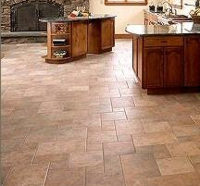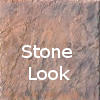
Porcelain Tile
(Yes, sometimes you do need to seal porcelain tile,
and you always need to seal the grout.)
How to:
Seal | Clean | Repair | Protect
Strip & Restore | Easy Care



High fired and very tough and durable. Many color, pattern, and texture options available. Replicates many other materials also, such as stone, slate, wood, etc.
Yes, many of the new versions of porcelain tile need to be sealed. If a water drop darkens underneath itself it indicates some level of absorption and that means a liquid can create a stain. And, of course, the grout needs sealing. See the appropriate sealer choices below.
Tip 1: The very textured finishes of modern porcelain tile will create haze left from the grouting process. This dulls the colors. Compare to the original, ungrouted tile in the carton to see the color you originally wanted.
Read why to not use a sealer (pre-sealing) to prevent grout smears.
Tip 2: These textured tile can be difficult to keep clean. That situation can be greatly improved by creating a low level gloss with super easy maintenance. That can be done with a light coating of a sealer or a "sealer protector".
Stone or Wood Look and other considerations:
Years ago porcelain tile was totally non-absorbent, therefore, not needing to be sealed except if a rough surface needed a little bit of sealer coating for ease of cleaning. These days, this tile has evolved into excellent replicas of other materials using machine texturing and color processes such as silk-screening. In this process, most of these tiles now have enough absorption and texture characteristics to justify the need for the right sealer. See below.
For textured face tile (looks like stone or wood) - do not use a sealer as a grout barrier (pre-seal).
Also these tile floors are difficult to clean because the texture traps dirt and grabs at the mop. To overcome those problems you need a thin, tough coating for tile and grout. This is accomplished with the appropriate sealer or "sealer protector".If you now have a grout haze to clean off the tile face, use the appropriate cleaner.
Efflorescence (subsurface originating white powdery stains) can occur on the grout. However, it is easily cleaned.
Grout can have light efflorescence, but that can be stopped by sealing with the appropriate sealer.
Some manufacturers ship their porcelain tile with a coating on the face to ease the grouting process (act as a grout release). The coating materials can vary from weak sealers to greases or oils. These coatings can cause problems after installation and should be removed after grouting. See the Aldon Problem Solving section for the Redoing a Previously Sealed Surface as these factory applied coatings fall within that category.
Sometimes porcelain tile will vary from batch to batch in terms of smoothness of finish. If the tile finish or color is uneven or "dull", test an appropriate sealer to even out gloss, enhance dull colors, and seal the grout in the same operation. A sealer's low gloss finish will also make cleaning easier.
Your Choices for Sealing
This surface is very low absorption. Water base penetrating sealers have a difficult time penetrating down. Solvent base penetrating sealers may require being sprayed to achieve a smooth finish.
Our suggestions to test are:- Penetrating petroleum solvent formulas with acrylic solids. These can be sprayed to finish nicely, but solids level might need to be adjusted if manufacturer allows dilution.
- Water based film forming that can flow out and self-level.
- Click here to see What effects you can expect from each sealer type.
- Click here to see our suggested sealers, cleaners, and application tools.
Some questions you may not be thinking to ask right now that could become important:
. Was it sealed in the past? Does that matter?
. Will a new sealer be compatible with whatever was used before?
. What sealer will give the visual results you want?
. Will you also be able to have a sealer solve problem(s)? ( Answer: yes. Just know which to pick.)
Items of Interest
How to select a sealer
A sealer can do far more than just bead water and look pretty! To see what that is click here.
Important: If your project has had any sealer applied in the past, it must be evaluated differently. To see why, Click here!
Sealer "solids" levels?
A porous surface will require more gallons (more money) of a lower solids sealer than using a higher solids level sealer. That, plus different surfaces have different requirements. It is only a matter of which is best for your needs.
The more porous the surface, the more solids will be required to achieve the desired effects of gloss, strengthening, stopping efflorescence, etc.
The more porous the surface, generally the greater the need for the sealer to create a stronger surface.
An old sealer below the surface, even after stripping, will lower the absorption and porosity to some degree. Sometimes it is uneven below the surface and can create an uneven coloring effect with a color enhancing sealer applied later. Another reason to test first.
Do not believe yet that you have the type of surfacing you were told:
Colors fading?
Renew a glossy finish
Re: "penetrating sealers": do not apply thin layer upon thin layer. Apply a sufficient quantity to insure below surface penetration & bonding. A layer of sealer on top of another layer of sealer can result in poor bonding between layers and that can cause separation peeling that looks grayish.
Concerned about Doing It Yourself or what your contractor says?
If you are concerned about doing it yourself - consider that the satisfaction of a project is directly related to YOUR knowledge of what needs to be done and how. Who actually does the work is less important.
The goal for contractors is - NO CALL BACKS. A good contractor will understand the logic of not taking shortcuts.
©
The goal for contractors is - NO CALL BACKS. A good contractor will understand the logic of not taking shortcuts.